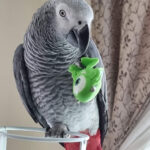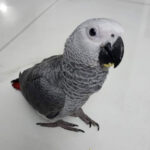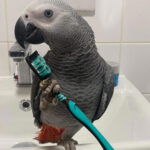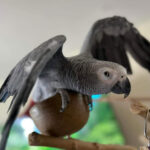- By chestergrey
- In Uncategorized
What can African grey parrots eat?
Your African grey should be eating fresh vegetables and fruit, along with pellets or seeds depending on what your bird will accept. You can home cook for your bird to make it more fun.
Is your parrot insured? Get a quote for up to £5,000 of vet fee cover, death and theft cover | We’ve been insuring exotic pets since 1996 | Check out our customer reviews on Feefo.
Diet categories | What to feed African greys‘ | Vegetables | Fruit | Flowers | Outside produce | Nuts | Pellets | Seeds | Animal protein | Sprouting and soaking seed | How much food? | How often to feed | Regurgitating food | Food recipes
Diet categories
For parrot species, four specialized diet categories have evolved, granivory (eating grains and seeds, nectarivory (eating nectar) frugivory (eating fruit) and palinivory (eating pollen).
For some parrots, we consider a fifth and generalist category, omnivory, which is one that combines one or more of the four specialized plant-food categories with animal protein. However controversy exists around the provision of animal protein.
Sprouting seeds suitable for African greys’
What to feed African greys’
The food choice for all captive birds is now enormous.
Pellets, seeds, grains, sprouts, fruits, vegetables, nuts, flowers, weeds and supplements.
Your first choice is whether seeds or pellets make up the bulk of the diet. Or whether you adopt a new trend which is to use mash and fresh food almost exclusively.
Seeds not pellets are what birds in the wild would eat. But in captivity seeds are lacking in micro-nutrients and should not be used exclusively for your parrot’s diet, as this will lead to poor health.
Neither seeds nor pellets contain enough Vitamin A. For this you need green vegetables and orange fruits.
Whether you offer pellets, seeds or chop as the principal part of the diet, your bird needs fresh produce.
A healthy bird that has been eating correctly will have bright eyes, shiny plumage and an upright stance.
What vegetables can African greys’ eat?
Most vegetables and salad are suitable for greys’. Some providers will avoid mushrooms, garlic and onions; others use them to no ill effect. Their use is controversial.
You can feed celery, spinach, asparagus, tomatoes, cauliflower, corn, spinach, Brussel sprouts, aubergine, kale, pumpkin, potatoes, collard greens, peas, carrots, cabbage, mustard greens, chillies, yams, and plantains.
Potato and tomato leaves are not suitable. Acorns are another arguing point however my aviary birds enjoy them.
What fruit can African greys’ eat?
You can serve any fruits available. Bananas, blueberries, strawberries, pineapple, watermelon, blackberries, cherries, grapes, kiwi, mango, orange, plums, pomegranate, pawpaw, passion fruit, raspberries, peach, banana peel, pears, raisins, dates, apples, papaya, melon, apricots etc. I have observed that my greys’ prefer tropical fruits to our fruit.
I would wash fruit from an unknown source.
I should note that current views consider commercially grown fruit contains too much sucrose. However, fruit are relished by Grey parrots. Their natural wild food is palm oil fruit. That would be too rich for captive birds except as a rare treat.
What flowers can African greys’ eat?
Greys’ love flowers and most are suitable. Those of us who make salads for our greys’ will use nasturtium, roses and pansies as edible decorations. Most popular with my flock are roses, marigolds and sunflowers which do have food value.
Some flowers are poisonous: Shamrock, holly, poinsettia, datura, laburnum, ivy, mistletoe, daffodils and lilies. A well-fed active Grey won’t generally touch poisonous plants. Although I would avoid having them in the home.
Produce collected out of doors
Some carers cultivate weeds for their flocks. Dandelions for example. Every part of the dandelion from flower to root is a valuable food source.
Chickweed are relished by breeding hens. You can also feed dock leaves, hawthorn berries, cotoneaster berries, milk thistle and similar plants, fir cones and branches.
An excellent addition to a Grey’s diet will also be items like wheat grass, lucerne, alfalfa or parsley that you can grow in pots outside the back door or on the balcony.
It’s sensible to wash produce gathered out of doors in a mild disinfectant in case of contamination.
What nuts can African greys’ eat?
African greys’ love nuts. Any and every variety, shelled or opened. They can eat cashews, brazil nuts, walnuts, almonds, pine nuts, macadamias, pecans, hazelnuts, shelled peanuts and pistachios.
Use them sparingly, never more than a few per day, for treats or for training.
The amount of nuts you give depends both on the individual and how much exercise she gets. A busy Grey flying round aviary or house and playing a lot can consume more nuts than a caged bird who doesn’t move much.
In training, breaking the nut up into slivers means that you can ask for more repetitions for any behaviour.
I’d expect an average training session to last up to five minutes and rewards would be three or four slivers of nuts. Pine nuts are valuable as training treats.
Coconuts are generally too hard for a grey’s beak, however empty shells make excellent foraging items.






